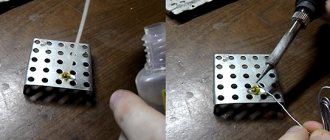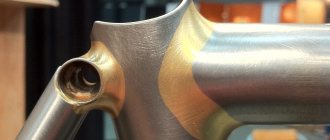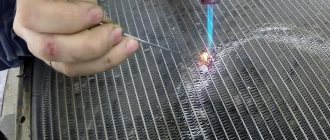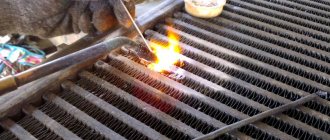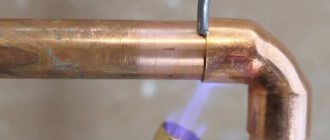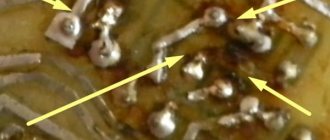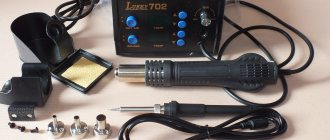Other soldering options: working with copper pipes and various metals
Soldering copper pipes requires some experience in this type of work. Therefore, if a home craftsman takes on such work for the first time, it is worth practicing beforehand so as not to redo a ready-made water supply or heating line several times. Soldering of copper tubes can be done either with hard solder (using a gas torch) or with soft alloys. In the second case, it is appropriate to use a high-power hammer soldering iron for copper pipes.
PHOTO: m-chel.ru Careful and high-quality soldering is the key to the durability of the connection
The nuances of soldering copper pipes: how to do it right
It is best to use rosin as a flux for soldering copper pipes. It is applied in an even layer to the outer surfaces of the pipe, after which the fitting is placed on it. The second part of the line is mounted on its reverse side. Next, the fitting is heated with a gas burner and solder is “laid” along the seams. Under the influence of high temperature it melts, filling the seam and creating a high-quality hermetic connection.
PHOTO: poliasmet.ru Sometimes you have to do without fittings
Soldering copper pipes with your own hands is not too difficult, but this work requires care and precision. Of course, not everything can be explained clearly in words, so we bring to the attention of our dear reader a video on how to solder copper with a gas torch, from which everything will become more clear.
Having dealt with the question of how to solder copper tubes at home, you can move on to the next problem, namely soldering non-identical metals (copper with aluminum, iron or stainless steel).
How to solder copper wire to aluminum
Soldering aluminum and copper is a rather complex process. It should be noted that the same solder is unlikely to be suitable for aluminum as for copper, and vice versa. It is much easier to combine these metals using a steel coupling. Although today the manufacturer offers special solders and fluxes for such purposes, their cost is significant, which makes such work unprofitable.
PHOTO: kak-eto-sdelat.info Soldering copper and aluminum is quite difficult
The whole problem lies in the conflict between copper and aluminum. They have different refractoriness and density. In addition, when interacting with copper, aluminum begins to oxidize strongly. This process is especially accelerated when electric current passes through the connection. Therefore, if it is necessary to connect copper and aluminum wires, it is best to use WAGO self-clamping terminal blocks, which contain Alu Plus contact paste inside. It is this that removes oxide from aluminum, prevents its subsequent appearance and promotes normal contact with copper conductors.
Having figured out how to solder copper to aluminum, you can move on to harder metals.
PHOTO: mastergrad.com Sometimes you can’t do without such a connection
How to solder copper and stainless steel
When soldering copper to stainless steel, it is not the solder material itself that plays a big role, but the tool used, although a lot depends on the consumables. The most acceptable materials in this case are:
- copper-phosphorus solder;
- tin-silver (Castolin 157);
- radio engineering.
Some craftsmen claim that with the right approach to work, even the most common solder based on tin and lead will do. The main thing is the mandatory use of flux (borax, soldering acid), thorough heating and only after this soldering (applying solder).
PHOTO: cusi3.ru Complex soldering of copper and stainless steel
Such connections are rare, and therefore specialized solders for such purposes are quite expensive.
Soldering copper with iron - is it possible?
This option is possible, but subject to certain conditions. For example, a simple propane torch is no longer suitable as a heater. Propane with oxygen must be used. You need to use borax as a flux, but brass will be the solder. Only in this case can we hope for a normal result. It is not difficult to buy solder for soldering copper with iron or stainless steel. The main thing is to understand whether the extra costs will be justified.
PHOTO: svarkavol.ru Soldering copper and iron tubes is also possible
And now we propose to look at how carefully home craftsmen can carry out the work of soldering pipes of mains for various purposes.
How to Solder Copper to Metal - Metalworker's Guide
When joining copper products, various tools and equipment are used, without which the soldering process would not be possible. The main tool is a soldering iron. In addition, you can use a gas burner or special ovens.
At home, it is preferable to use soldering of copper products; this option is the simplest and fastest compared to cooking. In addition, you do not need special equipment to carry out the fastening.
If all the rules and conditions of the technological process are observed, a strong and reliable connection of elements can be obtained, increasing resistance to various loads.
To ensure that soldering at home does not cause difficulties, first of all you need to take care of the basic tools that will be involved in this process:
- pipe cutter;
- chamfer;
- pipe expander;
- steel brush;
- steel brush;
- solder;
- burner or hair dryer.
For a tubular device, a method is used when the element is immersed in a composition of salt and solder. Salt acts as a heat source and replaces the functions of flux. Therefore, additional flux is not needed.
In addition to this method, there are several other soldering options that deserve attention.
Soldering copper
Brazing
The most common method of soldering at home is brazing copper. This is explained by the properties of copper, which melts easily at low temperatures. A soldering iron or gas torch is quite suitable as a tool. Soldering copper is a bit similar to the welding process, but still has some minor differences:
- When soldering parts, an additional substance, solder, is used, which connects these elements. This is possible due to the properties of solder, which has a low melting point.
- The most common materials for soldering parts are nickel and tin. These are affordable and simple components that are used in most cases. As for industrial use, other types of solder are used for these purposes, but for home use they are quite expensive and, therefore, unprofitable.
- To solder copper products, you must first melt the solder until it reaches the desired consistency in order to apply it to the place where the elements are soldered. After this, you should wait until the connection cools completely.
If all the nuances of the process are carried out exactly, then such a connection will be strong and durable.
Soldering in ovens
Soldering of copper in furnaces is carried out under production conditions. This process ensures uniform heating of the parts, completely eliminating its deformation. Tin or an alloy of tin and lead is used as an alloy; a composition of rosin and alcohol, or a composition of ammonium chloride or zinc, is used as a flux.
When using solder with a silver base, fluxes are used, which are based on compounds of fluorine, potassium and boron. These fluxes best clean the bonded surfaces from the oxide film, this will allow the alloy to be perfectly distributed over the entire surface.
Flux Soldering
This procedure has one big disadvantage, it is the implementation of a hermetic bond. Excess flux creates additional pockets that are subject to corrosion; as a result, soldering is performed in neutral conditions or in a reducing gas environment. To solder in nitrogen, the required temperature must reach 750–800 degrees.
Vacuum soldering
Vacuum furnace for copper soldering
Vacuum soldering is used for many metals, copper is no exception. Copper soldering is carried out in specialized furnaces, or containers, which are then placed in the furnace.
Despite the complex equipment, this option is considered the most effective by all criteria. Bonding of copper products is done with soft solder or pure tin.
You can use other types, for example, silver alloys, using a flux of rosin-alcohol solution.
In order to use cadmium solder, it is necessary to prepare a special tool and stock up on the necessary knowledge in this area, because the manufacturability of this material is much lower than that of tin-lead tinols.
Low temperature soldering
If the solder does not melt during soldering, do not rush, you must wait until the soldering iron heats up. After the alloy begins to flow, the heating source is removed, allowing the composition to independently fill the gaps between the elements. To avoid excess, it is not recommended to add alloy; in addition to excess, material may get inside the part.
If you solder copper using ordinary solder rods, then its volume should be equal to the diameter of the surface being connected. To roughly calculate the required amount of material, you can bend the rod into an L shape and attach it to the pipe.
With this technology, the strength of copper does not change, but the mechanical criteria are reduced.
High temperature soldering
High temperature soldering
This technology is suitable for those surfaces that will be used at high temperatures. Since to carry out this process the required temperature must be 700 degrees, a gas-flame heating option is used.
Readiness for soldering is determined using an alloy rod, which melts at the end of the process.
To increase the quality characteristics of the connection, it is necessary to preheat the solder rod.
The advantage of this joining method is the high strength of the seams, as well as their resistance during operation, under the influence of high temperatures. But there is also a drawback, which is the inevitable annealing of copper.
It is worth considering that when working with this method, you must have sufficient qualifications and experience, since a beginner can accidentally overheat the copper, thereby causing it to rupture.
Pipe soldering technology
To solder copper pipes, you need to prepare a pipe cutter. After the desired piece of pipe is cut, the outer cut is brushed to remove burrs and roughness. Using a pipe expander, the second section of pipe is expanded to the desired size so that one part of the pipe fits into the other.
Soldering copper pipes
Flux is applied to a pipe with a smaller diameter, and two pipe elements are fastened together. The joint is heated evenly; for this you can use either a torch or a hair dryer. Solder is applied to this place; after it melts, the surface will be completely covered with it. You can use soft solder as an alloy; it will do the job perfectly.
: Soldering copper pipes
How to solder copper with hard and soft solder
Copper products are found everywhere in different areas of life. For example, it is used to create strong and durable heating and water supply systems. But to connect the two elements, experts resort to a special technology - soldering copper pipes. The procedure requires suitable tools and materials, as well as knowledge. Since it has certain features that a beginner may not know about.
To solder copper, the master needs to have with him a composition such as solder. This thermoplastic substance seals the surface of the product and, under the influence of high temperature, melts, spreading over the entire joint. But as soon as it cools, it hardens and securely holds the products together.
The result is one item that has a long service life, withstands high loads, pressure and temperature changes, and is not afraid of ultraviolet radiation.
Solid
Among refractory alloys, only two groups are distinguished and widely used. These are mainly copper or silver alloys.
The first group includes solders made of copper and zinc. They are well suited for those connections that will only be subject to static loads. The fragility of these alloys does not allow their use in components that will experience shock or any vibration.
Copper solders or zinc-based compounds include PMC-36 and PMC-54. The first is an ideal solder for soldering brass and any other copper joints. The second is suitable for working on copper, bronze or steel parts.
If you need to connect two steel parts together, then you can use pure copper, brass grades L-62, L-62, L-68. These brass-based solders create stronger, more ductile joints. Copper alloys do not have these characteristics.
Silver alloys are considered the highest quality. The composition may also contain zinc and copper. PSR-70 – solder for soldering copper, for working with brass or silver parts. This element is suitable if the connection point must conduct electricity. PSR-65 is used in the production of jewelry, fittings, and water pipes. PSR-45 is necessary for connecting those parts that operate under vibration and shock loads.
What tools and materials are needed
Soldering is carried out not only at industrial facilities, but also at home. To do this, you need to prepare the following tools and materials:
- electric soldering iron or gas burner;
- pipe cutter;
- solder;
- flux;
- brush and steel brush.
How exactly to connect the products depends on the convenience and preference of the master. But the power of the device is selected in accordance with the melting temperature of the solder. Flux can be liquid or solid; each type has individual differences that should be taken into account. If the material is used in the form of a thickened mixture, then it is applied to the joint, both before and after the connection. Flux is needed to protect the surface from oxidation, promote solder flow and improve adhesion.
Application of flux
In order for the solder and the wire material to interact with each other, and the connection to be high-quality, the wires must be cleaned of the oxide film and only then soldered. For cleaning, you can use sandpaper, and for subsequent processing, use a special substance - flux.
Flux will not only clean copper wires, but will also create a thin protective film that prevents oxidation of the material.
It is allowed to use both solid flux - pine rosin, and liquid - various types of soldering acids or a homemade composition.
Sometimes, in order to correctly and firmly solder copper wires to each other or to any metal object, they use only liquid flux. You can prepare it by dissolving ordinary pine rosin in ethyl alcohol. Soldering acid is prepared independently by dissolving zinc granules in hydrochloric acid in the proportion of 412 grams of zinc per 1 liter of acid. But it’s better to buy ready-made flux that meets all quality standards, since bringing acidic compounds to copper wires is undesirable.
Types of fluxes and solders, features of working with them
Craftsmen know a variety of hard and soft substances that ensure high-quality soldering of metal products. 95% use tin, which is a low-temperature composition with slightly worse technical parameters. But it is valued for the fact that work can be carried out at any temperature without reducing the strength of the products being joined.
Connecting elements also include silver, which has excellent technological properties. Craftsmen often use three-component compositions of silver, tin and copper. Often, materials used in low-temperature soldering contain zinc chloride.
The advantage of soft solders is that they cover a larger area when applied to the surface of the part. They provide high strength and reliability.
Soft solders
Soft solder is used in the installation of water supply and heating networks, where the pipe diameter reaches 10 cm and the water temperature does not exceed 130 degrees. These types include:
- lead-tin type;
- with low tin content;
- special and fusible.
The influence of the characteristics of copper on the choice of method for welding it with steel
The choice of welding technology is influenced by the following features of copper:
- High thermal conductivity makes spot heating difficult.
- Rapid oxidation provokes clogging of the weld metal , making it heterogeneous and less durable.
- Copper, when melted, absorbs a large amount of hydrogen , leading to the formation of defects in the weld.
- The strong spreadability of molten copper makes it necessary to weld in the lower position using shims.
- The weldability of copper is greatly influenced by the qualitative and quantitative composition of the impurities included in its composition.
Why do you need solder paste?
Solder paste is a pasty mass consisting of small particles of solder, flux and special additives. Flux paste is used in industry when soldering elements on printed circuit boards. The paste is selected according to certain conditions:
- after application there should be easily removable particles;
- the substance must maintain viscosity and stickiness;
- do not have a negative impact on the surface being treated;
- do not leak onto clothing during melting.
How to work with the paste depends on the type and size of solder contained in its composition. The material also differs in the type of flux (rosin, water-washable, no-clean). It is necessary to hold small parts in place and facilitate the joining process.
Soldering technology
The process is quite simple, therefore, when it is necessary to connect something at home, the owner does the soldering with his own hands and without the involvement of specialists. But still, you can’t do without the preparatory stage.
It determines how high-quality and reliable the connection will be. First of all, you should pay attention to the cut of the part, which should be strictly vertical, without burrs, with even and smooth edges. If you find the slightest defects, you should take sandpaper and rub it over the surface until the defects disappear.
If two copper pipes are connected, then, having brought the cut to an ideal state, it is necessary to insert it into the fitting and then remove it. The part that came into contact with the fitting must be cleaned of oxidation. The next step is applying flux. There is nothing complicated about this, you just need to run the brush over the entire part, paying special attention to the joint.
Then the elements are connected to each other and firmly fixed. Further actions depend on what is being used for soldering - a gas torch or a soldering iron. Considering that the parts must be stationary, an assistant will be required. He will be the one to hold them, but if one is not found, you need to manage and do it yourself.
When something needs to be soldered at home, a solid compound is most often used. But the master can purchase special pastes. With the correct choice of compositions, it is possible to connect two pipelines or radio components as accurately and firmly as possible.
Soldering is performed at either high or low temperature. In the first case, the process is distinguished by high strength of the seam, and the connected area also gains heat resistance. Which is very important if it later serves as part of various communications. But high-temperature soldering is not allowed on threaded connections. Most often this process is performed with a propane-filled torch.
When low-temperature soldering is used, a soft compound, paste or gel is used. It is most suitable for a beginner master because it is simple and easy. In this type of process, the temperature does not rise above 425 degrees, so it is even possible to use a soldering iron, which is found in almost every home.
Working with a soldering iron
Every person has seen a soldering iron at least once in their life, and many constantly work with it. Therefore, they will not see anything complicated in soldering copper products with this tool. The whole essence of the process is that the solder located between the two parts is heated with a soldering iron until it begins to melt.
When it hardens, the two parts will be securely fastened into one. To solder efficiently, it is necessary to distribute the substance evenly over the entire surface, filling every gap. It is important to choose exactly the material that can withstand the high temperature of the soldering iron.
Working with the burner
The tool is turned on when the two parts are already connected to each other. You should not hold it near the joint for too long, since the combustion temperature is several thousand degrees. While you only need to heat a certain place to 250-300 degrees.
This will take 20-30 seconds. As soon as the flux changes color to dark, the compound to be joined is introduced. Important! The burner or hair dryer should be placed in the middle to cover the entire joint area.
Copper soldering: what is useful to know?
Soldering copper, as well as its alloys, is a fairly common procedure nowadays, since it is not uncommon for some home equipment to be made from this material. Thus, knowledge regarding soldering copper wires of electrical wiring, heating radiators, and any small household parts may be useful. Copper soldering of parts is a popular service of numerous companies engaged in repair and soldering of products made of various metals.
The Benefits of Copper: A Brief Course in Materials Science
Technically pure copper boasts excellent electrical conductivity as well as thermal conductivity. Copper also has a huge advantage because it is highly resistant to corrosion. Copper is a relatively strong and also ductile material.
With a decrease in gases, the ductility of copper increases to 62%. At elevated temperatures, the strength of the metal declines, while its ductility increases.
A remarkable property of copper is that it is capable of maintaining high ductility up to the temperature of liquid helium (-269 degrees C).
In order to increase the strength of copper as a material, as well as to give it positive properties, it is alloyed with all kinds of additives. It is worth noting that copper-based alloys boast significant mechanical properties and much more.
Materials, equipment and methods
Of course, when connecting copper products, special consumables and auxiliary materials, tools and equipment will be required. In most cases, the main tool during soldering is a soldering iron. Gas equipment (burner), or the use of special furnaces, as well as immersion in solder (tinol) can also be used.
Low-temperature solder is used during soldering due to the general availability of the material, as well as ease of use. However, there is one significant limitation when working with a soldering iron, according to which this tool can only be used with thin-walled parts at temperatures up to 350 degrees. C. Massive metal parts, due to their high thermal conductivity, are connected with gas burners.
For tubular heat exchangers, soldering is used by immersion in molten solders and salts. Salts serve as a source of heat and act as a flux, and therefore there is no additional need for the use of flux. During soldering using the method of immersion in a bath where the solder is located, the fluxed parts are heated in the molten solder, which fills all the gaps.
Capillary soldering
Capillary soldering of the material in question using low-temperature tinols is performed at gaps from 0.05 to 0.5 millimeters, as well as at temperatures from 650 to 900 degrees. C in argon or vacuum.
Capillary soldering of compounds obtained using indium, gallium, lova, POS40 and POS61 are not distinguished by excellent strength, since their tensile strength ranges from 40 to 70 MPa. During the procedure of joining copper with lead, a seam is formed that is not very strong, but at the same time ductile.
By using Pb-Ag-Sn-Ni system solder, it becomes possible to provide a connection with a tensile strength of 140 MPa with high ductility.
Soldering steel at home
Soldering of various metals is used in many industries today. Most metals are joined using tin-lead solders, and they are mostly suitable for bonding copper. To solder steel, you will need a certain tool, as well as materials and equipment that we will use at home. Thus, to connect steel products, you need to prepare refractory solder at home.
You will need the following:
- Zinc;
- Copper;
- Silicon;
- Nickel;
- Charcoal;
- Graphite crucible;
- Gas-burner;
- The soldering tool is more powerful.
Procedure:
- To prepare the first type of refractory tinol, you will need to prepare a graphite crucible, copper, zinc and charcoal. Next, you need to place a copper and zinc container in a ratio of 45% to 5%, respectively. Then you should melt the mixture under a layer of charcoal. In order to increase the fluidity of tinol, 0.3% silicon is added. After melting, the mixture for joining the steel must be stirred and poured into small molds. Such solder is available for soldering steel in the temperature range from 850 to 880 degrees. WITH.
- For a higher temperature for soldering steel, you need to change the proportion of copper and zinc composition and mix 60% with 40%, respectively. The flux can be a rust converter containing phosphoric acid or zinc chloride. Flux should be used for processing steel in conjunction with washing with a soap solution.
- To solder large steel, it needs to be preheated. A gas tool (torch) is used for this.
- The steel surface is cleaned and then treated with a solvent.
- The soldering iron tip is also cleaned and then rubbed with a piece of aluminum. Soldering of steel is carried out with a heated pin using gentle movements.
Soldering with silver solder
When you need to solder parts at home, silver solder is often used. It is beneficial because you can create it yourself. But it should not be used alone, in combination with zinc and copper.
Treated with this solder, the seam will be very strong and neat. The percentage of components is controlled by GOST 19746 74. But you can find out exactly what types of substances to use from the instructions of experienced craftsmen or those included with the products being connected.
How to solder copper and stainless steel
If you need to solder copper to another metal, such as steel, you will have to work hard. This process is not easy, but it is quite feasible. This is explained by the fact that stainless steel interacts poorly with other metals and is difficult to heat treat.
When two different products are combined, you need to find an average composition that suits both at the same time. In such cases, you have to sacrifice quality and it is not even necessary to use flux. But it is important to carry out preparation, tinning and other soldering steps.
The need for a connection often arises at home. Joining stainless steel and copper requires little time and a conventional gas torch is sufficient. Therefore, having decided on the tool and solder, you should clean the surface of both joints and prepare flux. Then tinning the bonding area and applying flux. After which the two parts are connected, and the resulting seam is coated with solder.
The next stage is its uniform heating with a burner. Once the solder has spread, the product is left to cool naturally.
Basic mistakes when soldering yourself
Most often, it is haste that leads to the fact that the connection of two elements is unsuccessful. Because they forget to inspect the surface of the parts being connected. The first action aimed at correcting an error is checking for the absence of defects. They could appear when cutting parts.
How reliable the seam will be depends on the cleanliness of the surface. Therefore, it is still worth brushing off even invisible specks of dust. One of the most basic mistakes is made when applying flux. The master may forget to process a small area of the product. And it will cause the proper connection to fail.
It is also important to monitor the temperature of the torch or soldering iron, since overheating of the element being processed leads to combustion of the flux. But insufficient melting point is also harmful. In this case, the connecting compounds do not soften or stick.
Theory
Copper is one of the oldest metals, which is used by people to create various decorations, devices and communications. It is characterized by high plasticity and pinkish-red color, sometimes with a golden tint. In the household, copper is most often used in water pipes and heating, because it does not corrode and is resistant to temperature changes.
Photo - copper connections
There are many types of soldering; capillary soldering is used for copper. It allows you to connect two parts of a pipeline or radio components as accurately and firmly as possible. This thermal effect is also divided into:
High-temperature soldering is characterized by higher weld strength. In addition, it allows the connection to be thermally stable, which is very important for various communications. But at the same time, this type of work is not used on threaded connections. To carry out such soldering, special equipment is required - a burner with piezo ignition and acetyl, propane.
Photo - copper elements
Low temperature is used when working with soft solders (pastes, gels). The main advantage of this technique is the simplicity and ease of work. It is carried out at a temperature lower than 425 degrees, so soldering can even be done with a soldering iron. It lies in the fact that, under the influence of a certain temperature, the solder applied to the gap between the part and the area being connected expands, closing the gap.
Selecting the power of the soldering iron
The power of the soldering iron must be selected based on the specifics of the work:
- From 20 to 50 W – for circuit boards, small electronics and thin wires;
- 100 W – for copper layers up to 1 mm thick;
- From 200 W – for large parts and wires.
The power is always indicated on the device packaging. In most models it is also indicated on the handle.
Soldering tools
Before starting work, you need to prepare special tools and devices for soldering copper connections. You will need:
- Gas or oxygen torch for soldering copper (with nitrogen, acetate, etc.);
- Solder (for capillary soldering according to GOST R 52955-2008);
- A brush (hard, but not metal) and abrasive paper for stripping copper connections;
- Fittings or other connected elements;
- Soldering flux.
It should be noted that if the work is done on pipe connections, then you may also need a chamfer, an expander, or a special cutting device. All of these fixtures can be found at a professional plumber so you don't have to buy them.
Photo - burner
Burners for copper are: professional (for working with hard solders), for heating pipes and soldering with soft pastes, semi-professional or combined. There are also special hair dryers that are used for soft soldering. They allow you to quickly heat the joint at temperatures up to 650 degrees.
- Solid. They are represented by rods of a certain diameter, which is selected based on a certain gap when connecting. It is used when connecting copper and iron in water supply systems, gas supply and air conditioning systems. This solder can be with phosphorus or silver;
Photo - hard solder - Soft ones can be either in the form of paste or thin wire up to 3 mm in diameter. They are produced with lead and tin. Also sometimes the process is carried out with orthophosphoric acid.
Also, to join copper alloys, it is necessary to use flux. It performs several useful functions: it promotes better spreading of solder over the metal, protects the processing area from an oxygen film, and cleans the seam from oxide. Fluxes come with borax (for various high-temperature solders), used for medium-melting compounds of gold, copper, bronze, cast iron, and stainless steel. Outwardly, they look like a paste and are applied with a special brush.
Photo - flux paste
Brushes and abrasive sheets (sandpaper) are needed to remove solder residues from the seam after finishing work. Fittings are selected based on the required connections (they can be branching, corner, curved, etc.).
Photo - soldering iron
How to solder parts from tin?
The standard method of soldering tin is to use solder, which contains a large amount of tin, flux and a soldering iron with an awl.
Professionals advise using the following brands of solder:
This choice of solder is associated with the chemical characteristics of the materials when soldering with tin is performed. In addition to tin, these solders also contain:
Brands and properties of solders.
These brands of solders differ in shear resistance due to a certain amount of impurities. In addition, they increase the tensile strength of the seam after soldering is completed. If there is not enough tin in the solder, then the amount of antimony increases.
In some cases, POS 90 with a large amount of lead is used. For galvanized material, a slightly different approach is taken.
To solder galvanized iron, flux must be present. It plays the role of a chemical oxidizing agent and at the same time a solvent. Thanks to flux, the oxidation process disappears. On top of that, the metal is wetted with iron, resulting in a high quality weld. Most often, hydrochloric acid and rosin are used as flux.
Welding
Let's look at how copper pipe soldering is done with your own hands:
- Any technology involves pipe preparation. You will need to cut the communication to the desired size and trim the ends with a bevel gun. This is necessary so that the next element is not damaged during connection and the maximum rigid adhesion of the parts is obtained;
- Soldering flux is applied to the edge of the copper pipe, and it is also applied to the fitting or other pipe. Afterwards you need to carefully insert the communications into each other. If soldering is done with self-fluxing solder or an electrode, then flux does not need to be used;
- The selected solder is inserted into the joint. It should be noted that if a paste is used, it must be applied after the flux. Under the influence of a certain temperature, the substance will begin to melt, filling the free space in the pipe. A very important point: the solder cannot be exposed to direct fire, it should melt only from the heat of the heated pipe;
Photo - soldering with solder - If tinning is used, then the flux and solder are applied in a very thin layer, otherwise an unsightly volumetric seam will form at the soldering site. If locks or radio components (usb, contacts) are repaired, this may disrupt the operation of the element;
- After heating is completed, the tool is removed. At this moment, the pipe cannot be moved - the connection is still too plastic, and turning the metal bends can damage the fastening. Copper pipes cool naturally;
- All that remains is to remove the remaining solder or flux with a brush, abrasive paper or brush. It is not recommended to overcool the joint during the first 24 hours, when the metal solidification process is not completed.
Photo - after cleaning
You can buy all the necessary tools used to solder bronze or copper at any electrical store; the price depends on the category. Burners cost from 3 dollars to several dozen, the cost of solder starts from 5 cu. e., flux - from 3.
Melting temperature
Whatever the type of solder, the temperature at which it begins to melt must necessarily be below the melting point of the materials being soldered. It should also be higher than the operating temperatures of the parts.
When we talk about melting point, we mean two points. This is the value at which low-melting components will begin the melting process, and the minimum at which the alloy will turn into a liquid. The difference between these two temperatures is called the crystallization interval. If the soldering site is within this difference, then even small mechanical loads on the part can completely destroy the structure of the solder. Such a connection will exhibit high fragility and resistance. Remember the main thing: you should not influence the connection in any way until the solder solder has completely crystallized.
